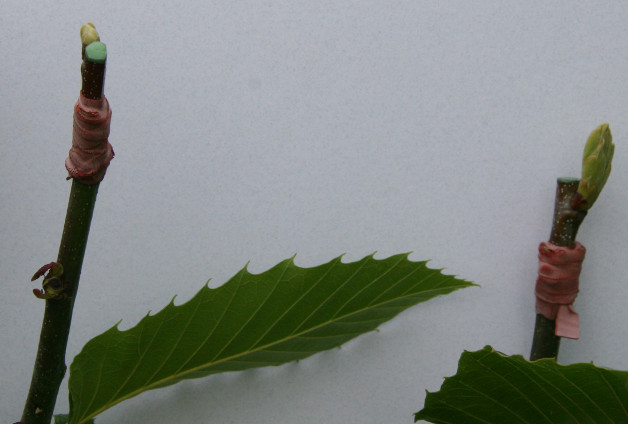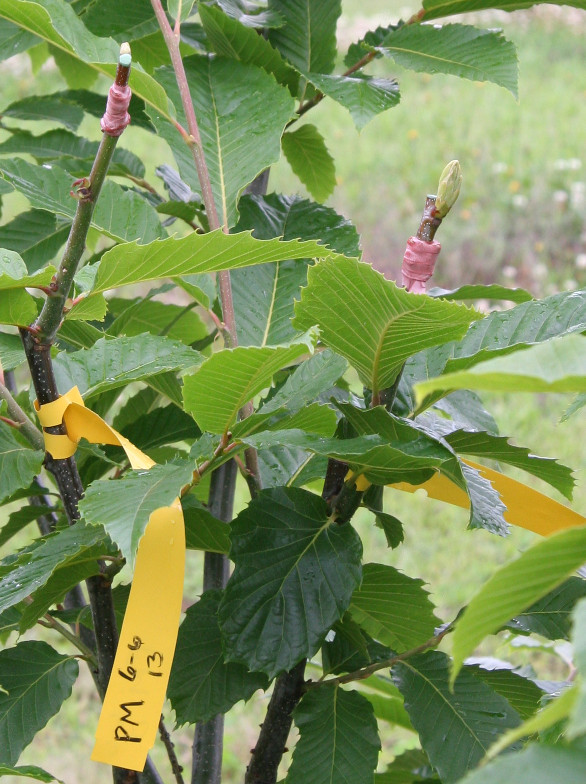| |
Remember those days when we were kids, we would say things like, "I want to be
a movie star", "I want to be a fireman", "I want to be a model", "I want to be
anything as long it is something special". Most chestnut trees are born from
a seed resulting in what we call a seedling. Being called a "seedling" doesn't
sound like something special, especially when we call some of the super stars
like Qing, Marrone, Colossal, Eaton, and Precoce Migoule by name. Seedlings
can be made into super stars by clonal grafting the tree with a compatible
name cultivar.
Sometimes a grafted tree will fail at the graft and returns to being a mere
seedling. These trees, with their intact root system, can grow very fast. But
to graft the tree to what was the original clonal cultivar is likely going to
result in another graft failure. Without knowing the genetics of the seedling,
we could only guess at what cultivar the seedling will be compatible with, if
anything. Our experience in our nursery found retrying a failed graft with the
same cultivar almost always results in another failed graft. Disposing of the
seedling appeared to be our only option.
Two years ago we started playing the numbers game with some of the seedlings
in our orchard that had graft failures. We graft thousands of chestnuts trees
each year, so our results, when statistics are applied, provide fairly
accurate extrapolations. Here is what we found:
Percent chance to take first graft of compatible named culivar: 70%
Percent chance to take second graft of same named culivar: 20%
Starting with 100 trees we get 70 good grafted trees with 30 trees rejecting
the graft and remaining seedlings. Appling the graft with the same cultivar on
the 30 trees results in 6 grafted trees and 24 seedlings. These numbers are
not so good when you really need 90%+ success rate to stay in business. What
can be done with the 30 trees that failed the first graft and trees in the
orchard where the tree had graft failure? Is there any way to get these trees
to the super star status?
Let's do a little more work with the numbers. If applying the same cultivar
results in only 20% success, then what happens if we try a different cultivar.
Depending on the adaptability of the cultivar, with some cultivars taking on
just about any seedling along the same genetic lines (European matched with
European, Chinese matched with Chinese), the results might be better than the
20% using the same cultivar again. Here is what we found:
Percent chance to take second graft of a different compatible cultivar: 70%
Percent chance to take second graft of same named culivar: 20%

Now we have 21 rising stars and 9 seedlings. This is great progress. So this
being great progress we went forward with seeing if it is possible to increase
this even more.
Applying statistics again, we find that attempting two different grafts with two different cultivars different than the first attempted cultivar we get:
Percent chance to take first graft of compatible named cultivar: 70%
Percent chance to take second graft of different compatible named cultivar: 70%
Percent chance to take third graft of yet a different compatible named
cultivar: 70%

Total is 210%, right? Well statistics says this is not right. But what do we
care about statistics when we are over our 90% success rate. Here are the
numbers once again:
First graft has 70 out of 100 trees take the graft, putting two grafts on the
same tree using different compatible cultivars with each having a 70% success
rate, 70 + 70 = 140% chance one of these grafts will result in a super star.
Wrong math again, probability math has it like this 0.7 + 0.3((0.7 * 0.7) +
2(0.3 * 0.7)) = 97.3%. Does our experience in the field show the same results?
Not exactly, some cultivars are very picky about their understock (rootstock),
some cultivars seem to take on just about any genetically similar understock.
The important lesson is to try a different cultivar if the first graft
fails.
|
|
|
|
Contact Information:
Farm Location:
6160 Everson Goshen Rd
Everson, WA 98247
Ph: (360) 592-3397
Email: chestnuts.wa@gmail.com
Business Offices:
Washington Chestnut Company
6160 Everson Goshen Rd.
Everson, WA 98247
Ph: (360) 592-3397
|
|


